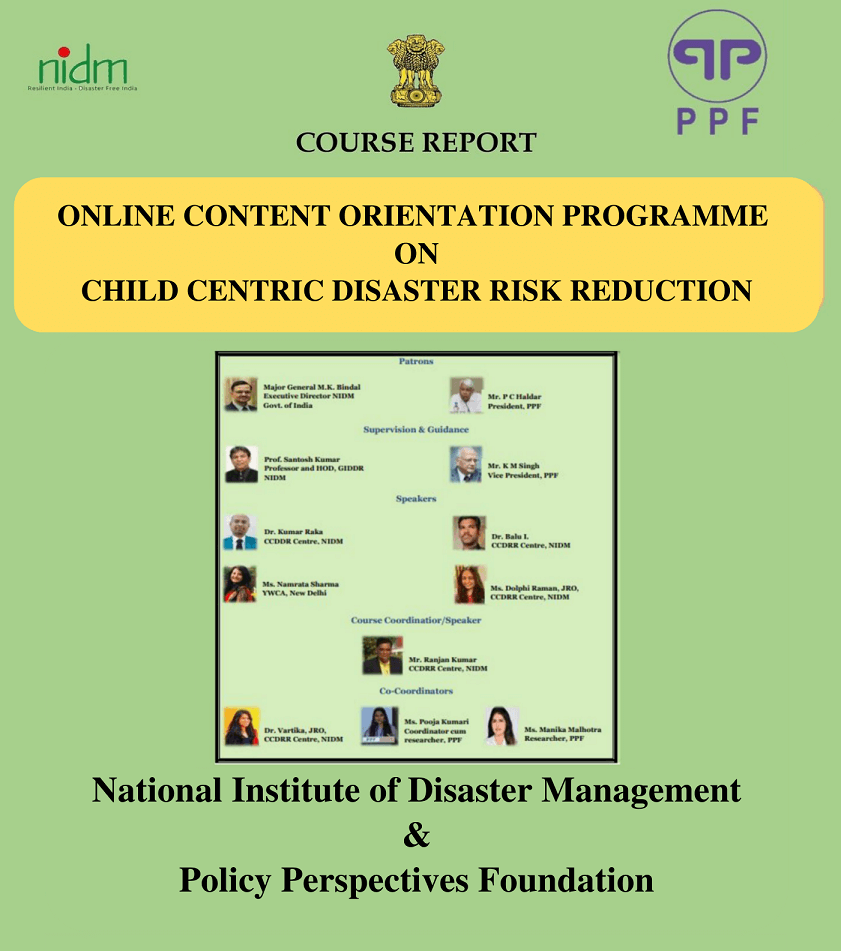
Published on: Jun, 2021
Online Content Orientation Training Programme On Child Centric Disaster Risk Reduction
Disaster managementDisasters threaten the lives, constitutional rights and needs of the children worldwide. In past two decades India have faced devastating disasters such as Latur Earthquake (1993), Odisha Super Cyclone (1999), Bhuj Earthquake (2001), Indian Tsunami (2004), Jammu & Kashmir Earthquake (2005), Bihar Floods (2008), Uttarakhand Floods (2013), Cyclone Phailin (2013), Chennai Flood (2015), Kerala Flood (2018), and Cyclone Fani (2019). Droughts are slow-onset disasters, adversely affecting children and women alike. Karnataka (16 districts) and Andhra Pradesh (4 districts) experienced at least 10 droughts between 2001-2015. During these emergencies, children are especially vulnerable to diseases, malnutrition, and violence and trafficking. Measles, diarrhoea, acute respiratory infections, malaria and malnutrition are the major killers of children during humanitarian crises. In future, vulnerability of children is expected to increase as the intensity and frequency of natural disasters rises.
INTRODUCTION
Disasters threaten the lives, constitutional rights, and needs of children worldwide. In the past two decades, India has faced devastating disasters such as Latur Earthquake (1993), Odisha Super Cyclone (1999), Bhuj Earthquake (2001), Indian Tsunami (2004), Jammu & Kashmir Earthquake (2005), Bihar Floods (2008), Uttarakhand Floods (2013), Cyclone Phailin (2013), Chennai Flood (2015), Kerala Flood (2018), and Cyclone Fani (2019). Droughts are slow-onset disasters, adversely affecting children and women alike. Karnataka (16 districts) and Andhra Pradesh (4 districts) experienced at least 10 droughts between 2001-2015. During these emergencies, children are especially vulnerable to diseases, malnutrition, and violence, and trafficking. Measles, diarrhea, acute respiratory infections, malaria, and malnutrition are the major killers of children during humanitarian crises. In future, vulnerability of children is expected to increase as the intensity and frequency of natural disasters rises. Keeping in view the increasing vulnerability of children from climate change and natural disasters, the National Institute of Disaster Management (NIDM), Ministry of Home Affairs, The government of India has established a “Child Centric Disaster Risk Reduction (CCDRR) Centre” to mainstream child-centric DRR activities through Training, Research, Advocacy and Consultancy.
-
Background
This Three Days online Training Programme on Child Centric Disaster Risk Reduction is intended for officials of State level sectoral departments, Administrative Training Institutions, and civil society practitioners to help build their knowledge, skills, and perspectives towards child-centric disaster risk reduction. This will help officials understand and prepare for risk-informed planning, sectoral readiness, and preparedness for emergencies so as children are not deprived of basic amenities.